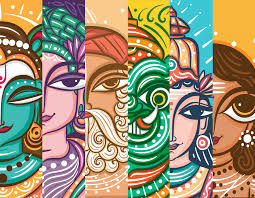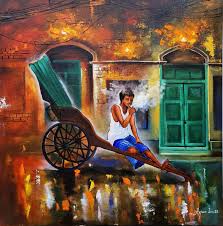
Menu

Rickshaw painting is one of Bangladesh’s most colorful and iconic urban art forms, transforming the humble three-wheeled cycle rickshaw into a rolling canvas of popular culture, dreams, and fantasies. Originating in Dhaka and other major cities, this art form emerged in the mid-20th century as rickshaw owners competed to make their vehicles more eye-catching to passengers. Over time, it developed into a distinct and exuberant visual tradition, instantly recognizable for its bold colors, glossy enamel finish, and dramatic imagery.
Artists who specialize in rickshaw painting use tin panels, wooden backs, and canopies as their canvas. Their subjects range from movie stars and romantic scenes to floral patterns, animals, religious motifs, and idealized landscapes. It’s not unusual to see fierce tigers, soaring birds, or mountain waterfalls side by side with portraits of Bollywood heroes or local celebrities. The paintings are framed by ornate borders and swirling designs, making every inch of the rickshaw a spectacle of color and detail.
Rickshaw painting is more than mere decoration—it reflects popular tastes, social aspirations, and the artist’s creativity. For drivers, a beautifully painted rickshaw is a source of pride and better business, attracting passengers with its aesthetic appeal. For the public, it’s a form of accessible, everyday art, bringing vibrancy to crowded city streets.
Although its popularity has declined somewhat in recent years, with mass-produced stickers replacing hand-painted panels, there is growing interest in preserving this art form as cultural heritage. Museums, galleries, and urban art projects have celebrated rickshaw painting for its folk-pop style and social history. Artists continue to adapt, creating pieces for export and exhibition. At its heart, rickshaw painting remains a testament to Bangladesh’s love of color, storytelling, and the creative spirit that turns even daily transport into art.
Ask ChatGPT

@THE INDIAN ART COTTAGE
© The Indian Art Cottage | All Rights Reserved | 2025